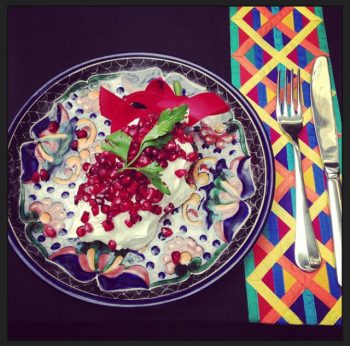What to eat to Celebrate Mexican Independence Posted by Karoly Molina on Sep 17, 2020 in Uncategorized
September is a very colorful month in Mexico! Everywhere you go, the Mexican flag is displayed proudly to commemorate our independence from Spain. This year, we celebrate 212 years of independencia; if you want to know more about the fight for independence and the celebrations, you can read this post I wrote. In this post, I want to explore some of the typical dishes you can enjoy.
Chile en Nogada
The most popular dish, and quite frankly, one of the most beautiful is the Chile en Nogada. This dish consists of a chile poblano filled with a picadillo made with a mix of ground beef and ground pork, nuts and dried fruits, covered with an absolutely delicious walnut-based cream and garnished with pomegranate seeds and parsley. The dish features ingredients that are at peak season and that display the colors of the flag.
It is said that a groups of nuns or monjas created this dish when Mexican general and politician Agustín de Iturbide stopped at the convento or convent after signing the declaration of independence. In the cookbook “Larousse: Los clásicos de la cocina mexicana,” the chef Ricardo Muñoz Zurita explains that this dish existed before the signing of the independence and was usually passed down from mother to daughter.
You can find chile en nogada between mid August and early October in most restaurants in Mexico. There are a few restaurants that can make this dish year-round. You can have the chile capeado with flour and egg or natural and it is usually served at room temperature. If you are ever in Mexico during the independence festivities and want to eat one of the best, I highly recommend the restaurant Azul from chef Ricardo Muñoz Zurita. Not only do they serve a delicious chile en nogada, each year, there is a new ‘ceremony’ when you are served. If you want to try making the dish yourself, the Larousse cookbook I mentioned above has two great recetas.
Below is a short clip of the history of this iconic Mexican dish.
Pozole
Another typical dish to enjoy with the independence celebration is pozole. This is a very delicious soup/stew made with hominy or maiz pozolero and pork. There are three different types of pozole: blanco, rojo o verde (this is a common theme in our cooking). The white version is just basically the hominy and pork, while the red and green versions also have chiles that give them the color.
Pozole is a pre-colombian dish. The Aztecs considered corn to be a sacred ingredient and reserved this dish for special occasions. Legend has it that pozole was made with the dismembered body parts after a human sacrifice. The meat was boiled with the maiz and only the very powerful could enjoy this delight. Shortly after the Spanish arrived in the Americas, they provided pork or carne de cerdo as a substitute for the human meat. Some historians refute this argument basing it on a smear campaign from the colonizers making the Aztecs and others seem like monsters to justify violence and their erradication. While I don’t think we will ever know if pozole was really served with carne humana or not, the dish does date back to before the Spanish invasion making this dish ever so important in the independence celebrations.
Below is a video with more details of this slightly disturbing urban legend.
What do you eat to celebrate your country’s independence? Have you ever tried pozole or chile en nogada?

Build vocabulary, practice pronunciation, and more with Transparent Language Online. Available anytime, anywhere, on any device.





Comments:
Rachel:
Para mis celebraciones, como el día de acción de gracias, lo celebro comiendo pavo y el pan de mi abuela.
Karoly Molina:
@Rachel Hola Rachel, La celebración de acción de gracias es una de mis favoritas!
Cole Trier:
Para mis celebraciones, yo como pan, pollo, bistec, y papa fritas. Yo beber jugo de naranja y agua. ?Que te gusta comer para mis celebraciones?